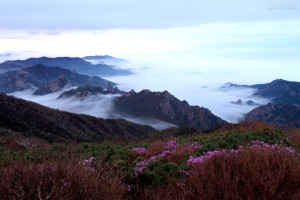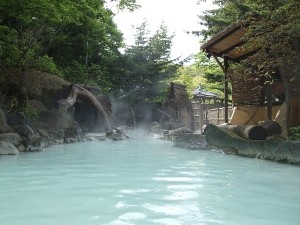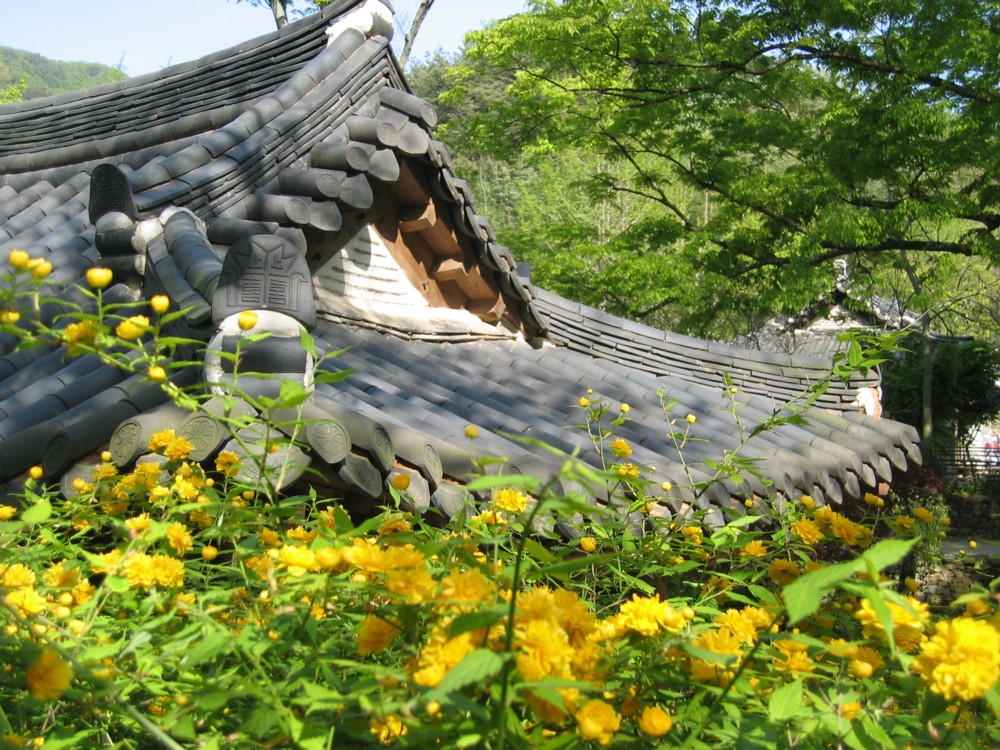
Enjoying Spring Season as the Koreans Do
The past weekend’s sunny skies and warmer temperatures seem like a cruel tease with the sudden plummeting of temperatures over the last few days. Koreans call this sudden drop in temperatures just before spring “꽃샘추위” or kkot-sem-choo-eui, when the skies are said to become envious of the flowers beginning to bloom and bringing on a temporary chill (in fact, this poetic phrase literally means “flower envy coldness”). But there’s a bright side to this alleged malicious chill as it usually signals that spring is on the cusp of making a full return.

Koreans say the chill right before spring is because the skies are envious of the flowers beginning to bloom
Koreans have a special fondness for the spring season as reflected in the multitude of poems and songs dedicated to the season. If you haven’t experienced springtime in Korea in full yet or will soon face your first Korean spring, here are a few suggestions to break you free from winter hibernation mode and enjoy it as the locals do.
Bask in the Glory of Korea’s Cherry Blossoms
The most popular and obvious choice is to go watch the cherry blossom trees in bloom. Cherry blossom trees are in bloom for only a short time in spring every year and start south in Jeju Island before the bloom climbs its way up north. Their arrival depends yearly on weather conditions and location but this year the cherry blossoms look to be starting off a bit earlier from around March 27 in Jeju Island and around mid-April by the time it reaches Seoul and Incheon. Here’s a prediction map of the bloom for Korea’s major cities below:

This year’s expected start of the blooming of cherry blossoms around Korea’s respective major cities.
Cherry blossom trees are scattered about the Korean peninsula from residential neighborhoods to temple grounds in the mountains. The most famed spots for viewing include Jinhae, Seoul’s Yeoido, Hwagae, etc, but you can expect packed crowds in these areas when the trees are in full blooms (especially on weekends). But crowds or not, the magical experience of standing under the swaying pink trees with cherry blossom petals falling like snow is one that everyone in Korea should experience at least once.
For more about Korea’s cherry blossom click here to find out more!
Experience the Delicate Tastes and Fragrances of Korean Namool Cuisine (Greens and Roots)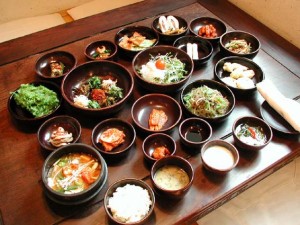
As a mountainous nation, the variety and extent of dishes made from sanchae namool (산채나물) or wild greens, herbs, and roots is absolutely staggering. Blanched, fried, or eaten raw and mixed with a simple dressing, the flavors and scents can all wildly differ from each other to (as the Koreans say) “give you a taste of spring in your mouth.” They are also nutritious with delicate flavors so they’re usually given minimum cooking and refrained from being over seasoned to let their subtle scents shine.
One of the best known ways to eat namool is in your standard bibimbap but for a special variety in tune with the season, look for restaurants that offer “sanchae bibimbap” (산채비빔밥) or “wild herbs bibimbap.” This special bibimbap will include a special mix of seasonal herbs and roots that brings about an extra dimension beyond the usual bibimbap you may have already had.
Korean restaurants that offer spring herbs and roots course menus such as “namool babsang” (나물밥상) or “sanchae jeongshik” (산채정식) are also a great way to get in both the great flavors and nutrition of spring. In these meals, an array of various sanchae namool side dishes will be provided along with a main dish or two, stew, and sometimes rice that’s been cooked with more namool. These kind of restaurants are especially common near popular mountains and national parks but sanchae namool restaurants are found in just about any city. Buddhist temple cuisine restaurants, such as a few well known places in Seoul’s Insadong, will also offer also similar dishes.
Experience Spring With All Your Senses While Mountain Climbing
Speaking of mountains, as the plethora of older Koreans dressed in outdoors wear of all neon shades (and seen on a daily basis) shows, mountain climbing isn’t just a hobby, it’s a lifestyle for many here. The mountains and hills found throughout the country are of varying degree in difficulty with each their own merit. But their beauty is best experienced in spring and autumn when the snow begins thawing in the higher mountains and pockets of colorful wild flowers (such as azaleas) bloom. From the bird cries echoing in the forest to the sweet scent of pine collected with dew, it’s a wonderful exercise for all your senses.
Bukhansan near Seoul, Taebaeksan and Seoraksan in the east, Jirisan and Yeongchwisan in the south are all some of the most popular choices in spring but you’re never seemingly more than a stone’s throw away from at least a hill of some kind in Korea so ask around about local hikes if you don’t want to venture too far out. Just remember to do plenty of research on the mountain, dress appropriately, pack accordingly, and get ready to take a lot of beautiful pictures!
Thaw From the Winter at a Jjimjilbang or Hot Springs
Sure, taking a big bath and washing away the remnants of the past year is traditionally more associated with the start of the new lunar year but it’s never too late for a good soak! If you haven’t overcome your fear of trying out a jjimjilbang yet, this is the perfect time to get your body in line with your renewed mind and spirit for the arrival of spring and also get yourself squeaky clean. Koreans believe starting off the new year with a refreshed and clean body- free from any lingering impurities and negatives from the past year- is a good way to start off the new year on the right foot. But since the new year has long passed by now, you can avoid the crowds yet get clean and relaxed in time for spring.
For a trip further out, try one of the many hot springs (called 온천 or “oncheon” in Korean) that are found throughout the country. Distinctions at some of these hot springs include being among the oldest in Korea (such as Onyang Oncheon in Asan) to ones with special properties (such as the bubbly carbon waters of Sanbangsan in Jeju Island). Many hot springs have lodgings attached to, or close by, the hot springs making it just the thing for a relaxing weekend with friends or a significant other. You’ll be thawed from the winter in no time!
Pack a Meal to Go and Enjoy a Picnic
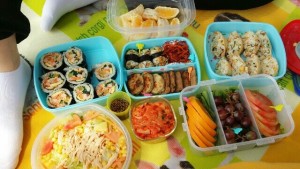
For Koreans, one of the most stereotypical images conjured by the word “spring” is sitting under a grove of cherry blossom trees and enjoying a spread of picnic foods with loved ones.
Parks, river banks, hills, and other outdoors area are popular spots to enjoy the much welcome warmer weather and what better way to enjoy them with delicious food? Popular food commonly packed for picnics include kimbap, yoobuchobap (rice stuffed tofu skin pouches), rice balls, finger sandwiches, fresh fruit, salads, and more, which can be made into some pretty creative packed meals. Even if cooking isn’t your forte, Korea has you covered as you can easily find restaurants that deliver food of all kinds to where you are (and no delivery fee, as usual) or you can even find boxed meal sets at your local convenience store. And in Korea it’s perfectly legal to enjoy a drink in public so bring a few beer cans if you want or even a bottle of wine if you’re feeling fancy.
Don’t forget to pack some music (but not too loud a volume so you don’t disturb your neighbors), maybe a frisbee to toss around, a book to enjoy, and all thoughts of winter will soon be banished.
Hop on a Train to See Spring in Other Parts of Korea
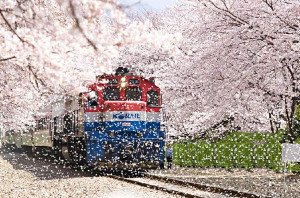
While cars are the convenient method of transportation for short term trips to other parts of Korea, they don’t quite hold the special fondness in the hearts of locals as much as a train ride in spring does. And Korea’s extensive rail network means that you can get to just about everywhere in Korea in well-maintained, clean, and (usually) timely trains that takes you through rolling farm fields, forested mountains, and by shimmering rivers and streams. The picturesque scenery you’ll pass through along the way makes it a more memorable way of traveling rather than stuck in traffic on a highway.
Along the way, snack like the locals do on bites such as hard boiled eggs, sandwiches, steamed sweet potatoes, or boxed lunches and let the gentle lull of the train on the tracks help get you lost in the beauty that surrounds you.
And if you’re having trouble deciding where to go, check out this link for a list of festivals for the spring of this year as a way to inspire your mind.

